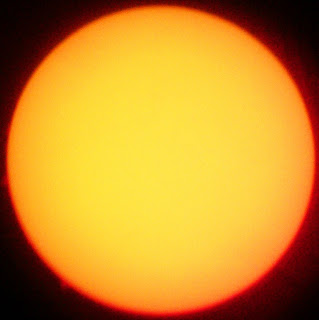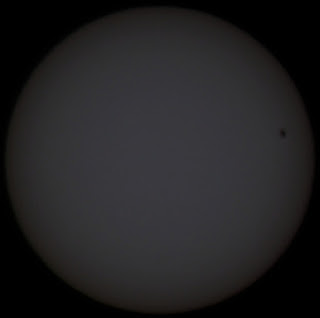May 30th 2200 GMT
After a cloudy day, it cleared somewhat. There was some haze around, mostly to the north and west. I went out with my DSLR at 300mm focal length, ISO 6400 and 2 seconds exposure. I snapped each object, then shot a few blanks at the end.
I started with Jupiter but struggled to find focus.
Next was Albireo. I did not get the colour contrast, as I had to remove the red channel, due to noise.
I went for Deneb, then the west and east of the cross.
I ended with Polaris but it was too cloudy to get anything useful.
May 30th 2350 GMT
Mars and Saturn were low and conditions were still hazy. I decided on a binocular tour. Jupiter showed just one moon. Mars showed a disc and Saturn's rings were visible, although not the gap between the rings and planet. None of the Messier objects was visible and Melotte 20 (admittedly low down) and Melotte 111 appeared sparse, with just the brighter stars visible. I had a look at Albireo and I could just make out the secondary component.
It wasn't a memorable night but nice to get out under a relatively dark sky.
May 29th 2140 GMT
I looked out to assess the prospects for planetary observation. Saturn was barely visible in the murk and the sky was peppered by light cloud. I saw the ISS pass from west to east and it was noticeably brighter than Jupiter and Mars. The fade was very slow and it did not disappear into Earth's shadow when it set.
May 29th 1000 GMT
I checked the Sun with my PST. The solar disc was mostly featureless but I found a small prominence that I managed to capture on some of my close-up images.
MORE TO COME...
May 29th 0950 GMT
I did a solar shoot with my Mak and DSLR. I used ISO 400 and 1/2000 second exposure, which I had previously found good. I did not notice any sunspots through the viewfinder.
May 28th 1800 GMT
Conditions had been hazy all day. It cleared a little bit by evening but a solar bin scan did not reveal any sunspots.
May 25th 2315 GMT
I did a shoot with my DSLR at ISO 400. I started with the Moon at 1/1000 second and 300mm focal length.
I adjusted the focal length to 75mm and exposure to 6 seconds to capture Mars, Saturn and Antares.
I moved to Jupiter at 300mm and 2 seconds exposure to capture its moons.
I tried a similar shot with Saturn to try and capture Titan, then some shorter exposures in an attempt to capture the rings.
Looks like Titan to the left of Saturn.
The ring shot almost worked.
Looks like Titan to the left of Saturn.
The ring shot almost worked.
May 24th 1015 GMT
I did a white light shoot with my Mak and DSLR at ISO 400. The best results appeared to be at 1/2000 second exposure.
I then tried a "proof of concept" shoot with the DSLR and solar filter. It seemed to work best at ISO 100 and 1/4000 second exposure. I was rather pleased with the result.
May 23rd 2145 GMT
I went out with my Mak, eyepieces and compact digital camera. The idea was to do some afocal shots of Jupiter and Mars. I also wanted to have a look at Mars, in particular.
Although Jupiter was well past opposition, it was high in the west. I could see the cloud belts and polar shading.
I caught the moons, although it wasn't as good as with my DSLR.
I caught the main cloud belts and a bit of shading.
I caught the moons, although it wasn't as good as with my DSLR.
I caught the main cloud belts and a bit of shading.
I struggled with Mars and it did not take high magnification. I could see some darker patches, once though to be vegetation, and a hint of the polar cap. The ice cap did not appear in the image.
Finally, the Moon was visible, although rather low. I could not get the whole disc into the field of view, so I took several afocal shots in an attempt to stitch them to obtain a full disc. I did not obtain a full disc but ended up with three regional shots.
May 23rd 1310 GMT
I bin scanned the Sun and saw a single, large sunspot.
May 22nd 2230 GMT
After a few days of bad weather and illness, I finally ventured out. The Moon was covered by cloud but Jupiter wasn't. I did a quick set of Moon shots at 2 seconds' exposure.
Unfortunately, I had not managed an accurate focus, so had nothing to show.
May 16th 0710 GMT
I took some full disc solar shots with my Mak and DSLR. The large sunspot was obvious, even in the camera viewfinder. I managed to get 28 full disc images to stack, not easy with solar images.
May 15th 2110 GMT
I took a set of photos with my DSLR:
Moon
May 15th 0940 GMT
I did a white light shoot with my Mak and DSLR. New sunspot activity had rotated on. Theimages would not stack, so I processed a single frame.
May 15th 2300 GMT
I started off with my DSLR and shot a few full disc lunar disc shots. I stacked 52 images and finished in GIMP.
They seemed to be good, so I tried using my 3x Barlow lens, giving a focal length of 4620mm. This showed some rather nice lunar close-ups. I would say, though, that recent results with the webcam were better.
I had trouble finding Jupiter and Mars. I abandoned the DSLR and used my compact digital camera afocally instead. I used a moon filter to reduce the glare I had on Jupiter during my previous attempt. Both planets seemed to produce more detail at 77x magnification than 231x with the Barlow lens. The two main cloud belts on Jupiter were very sharp, with some polar shading.
Mars showed some darker features that appeared to correspond to the side of the planet opposite Syrtis Major. It was my first view of the planet for ages.
May 14th 1330 GMT
I checked the Sun with my PST but it seemed rather quiet. I took some full disc and close-up shots.
May 14th 1100 GMT
I bin scanned the Sun in a clear sky but did not see any sunspots.
May 12th 2100 GMT
It was twilight but I’d had a long day and an early start the next day. I did a few full disc frames of the Moon and some of Jupiter with its moons.
Well OK, I never DID claim to be some sort of expert and forgot I was using my Maksutov and not a 300mm lens. As a result, Jupiter and its moons trailed for 2 seconds, instead of the more realistic exposure time of half a second or less. As I captured all four Galilean moons I still thought the photo was worth sharing.
May 12th 0840 GMT
As those of you with corporate PCs will know, I had a forced restart. Good thing I wasn’t in a conference call! Only one thing to do: I bin scanned the Sun in hazy conditions. I didn’t see the fainter sunspots on the Big Bear images but I caught the larger pair that had been around for a few days.
May 8th 1615 GMT
I checked the Sun in hydrogen alpha light. It was rather quiet, apart from the sunspot. I took some full disc and close up shots.
May 8th 1500 GMT
It was two sunspots for the price of one, as the sunspot had split.
May 7th 1520 GMT
I caught a gap in the clouds and saw that the sunspot was larger but had somewhat lightened.
May 6th 2215 GMT
I went out with my Mak to see Jupiter. Neither Mars nor Saturn were visible.
The best views were at 103x magnification, showing 3 cloud belts and polar shading. The view at 309x magnification was rather hazy, by comparison and showed less detail. My initial look at the photos suggested that they were well over-exposed and needed a variable polarising filter for the afocal method to work properly.
May 6th 2150 GMT
I went outside with my DSLR to shoot Jupiter with is moons. I shot 10 darks as well. It was rather hazy outside, so I did not attempt any deep sky shots.
May 6th 0915 GMT
Conditions were cloudy but I proceeded with a binocular scan. It took a while to find it but I saw the sunspot.
May 5th 0640 GMT
There was a new sunspot group that had rotated onto the solar disc from the day before. I took some frames in white light and hydrogen alpha light.
May 4th 1220 GMT
I was hoping that, as the Sun was higher in the sky, I would see more detail in hydrogen alpha light. Unfortunately, I could not but I took a few frames of the full disc and some close-ups anyway.
April 4th 0655 GMT
The Sun was rather bland in hydrogen alpha light, apart from some plages near to where I’d seen the sunspot on the Big Bear images. I took full disc shots and only close-ups of the region of interest.
May 4th 0635 GMT
The Big Bear images showed a single faint sunspot. I tried the Mak and DSLR to see if I could get in on “film”. The sunspot is hardly visible.
May 3rd 1220 GMT
I bin scanned the Sun in clear sky but could not see the faint sunspots visible on the Big Bear images.
May 2nd 1640 GMT
I checked the Sun with my PST, only to find it was rather quiet and I could just see some plages.
May 2nd 1550 GMT
It finally cleared and I bin scanned the Sun but didn't see any sunspots.
May 1st 0920 GMT
Conditions were hazy from the night before. I did a photo shoot with my Mak and DSLR but indications suggested that I had not captured any sunspots.




















































































